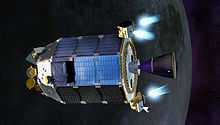Kepler-76b
| Extrasolar planet | List of extrasolar planets | |
|---|---|---|
| Parent star | ||
| Star | Kepler-76 | |
| Constellation | Cygnus | |
| Right ascension | (α) | 19h 36m 46.11s |
| Declination | (δ) | +39° 37′ 8″ |
| Apparent magnitude | (mV) | 13.3 |
| Mass | (m) | 1.2 M☉ |
| Radius | (r) | 1.32 R☉ |
| Temperature | (T) | 6409 K |
| Metallicity | [Fe/H] | −0.1 |
| Physical characteristics | ||
| Mass | (m) | ~2 MJ |
| Radius | (r) | 1.25 RJ |
| Geometric Albedo | (Ag) | 0.23 (visible light) |
| Density | (ρ) | 1.4 g cm−3 |
| Temperature | (T) | 2250 |
| Orbital elements | ||
| Semimajor axis | (a) | 0.028 AU[1] AU |
| Eccentricity | (e) | ~0 |
| Orbital period | (P) | 1.54492875 d |
| Inclination | (i) | 78° |
| Discovery information | ||
| Discovery date | May, 2013 | |
| Discoverer(s) | ||
| Discovery method | Stellar flux variations due to relativistic beaming, Transit (Kepler Mission) | |
| Other detection methods | Radial velocity, Orbital light variations, Ellipsoidal light variations | |
| Discovery status | Confirmed | |
Kepler-76b is a gas giant with the mass about two times of Jupiter.[2]
It is a Hot Jupiter that orbits its star every 1.5 days. Confirmed with Trans-Atlantic Exoplanet Survey and SOPHIE échelle spectrograph.
Detection
The planet was discovered by observing the amount of stellar flux reaching the Earth. The existence of the planet was confirmed by also observing the reflected starlight from the planet, the shape of the star due to gravitational tug from the planet and radial velocity method. Finally, part of the planet was found transiting the parent star with secondary occultation also being detected.[2][3]
It is the first planet detected using Einstein's special relativity.
Characteristics
Kepler-76b is slightly denser than Jupiter indicating that it is not a Puffy planet.
References
- ↑ "Kepler Discoveries". kepler.nasa.gov. Retrieved May 14, 2013.
- ↑ 2.0 2.1 BEER analysis of Kepler and CoRoT light curves: I. Discovery of Kepler-76b: A hot Jupiter with evidence for superrotation: Simchon Faigler, Lev Tal-Or, Tsevi Mazeh, Dave W. Latham, Lars A. Buchhave
- ↑ "New Method of Finding Planets Scores its First Discovery". kepler.nasa.gov. Retrieved May 14, 2013.
External links
- Table of confirmed planets at NASA, Kepler mission
| ||||||||||||||||||||||||||||||||||||||||||||||||||||||||
| |||||||||||||||||||||||||||||||||||||||||||
